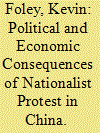| Srl | Item |
| 1 |
ID:
167074


|
|
|
|
|
| Summary/Abstract |
What are the consequences of nationalist unrest? This paper utilizes two original datasets, which cover 377 city-level anti-Japanese protests during the 2012 Senkaku/Diaoyu Island crisis and the careers of municipal leaders, to analyse the downstream effects of nationalist unrest at the subnational level. We find both political and economic consequences of China's 2012 protest demonstrations against Japan. Specifically, top Party leaders in cities that saw relatively spontaneous, early protests were less likely to be promoted to higher office, a finding that is consistent with the widely held but rarely tested expectation that social instability is punished in the Chinese Communist Party's cadre evaluation system. We also see a negative effect of nationalist protest on foreign direct investment (FDI) growth at the city level. However, the lower promotion rates associated with relatively spontaneous protests appear to arise through political rather than economic channels. By taking into account data on social unrest in addition to economic performance, these results add to existing evidence that systematic evaluation of leaders’ performance plays a major role in the Chinese political system. These findings also illuminate the dilemma that local leaders face in managing popular nationalism amid shifting national priorities.
|
|
|
|
|
|
|
|
|
|
|
|
|
|
|
|
| 2 |
ID:
139560


|
|
|
|
|
| Summary/Abstract |
Why do some Chinese cities take part in waves of nationalist protest but not others? Nationalist protest remains an important but understudied topic within the study of contentious politics in China, particularly at the subnational level. Relative to other protests, nationalist mobilization is more clustered in time and geographically widespread, uniting citizens in different cities against a common target. Although the literature has debated the degree of state-led and grassroots influence on Chinese nationalism, we argue that it is important to consider both the propensity of citizens to mobilize and local government fears of instability. Analysing an original dataset of 377 anti-Japanese protests across 208 of 287 Chinese prefectural cities, we find that both state-led patriotism and the availability of collective action resources were positively associated with nationalist protest, particularly “biographically available” populations of students and migrants. In addition, the government's role was not monolithically facilitative. Fears of social unrest shaped the local political opportunity structure, with anti-Japanese protests less likely in cities with larger populations of unemployed college graduates and ethnic minorities and more likely in cities with established leaders.
|
|
|
|
|
|
|
|
|
|
|
|
|
|
|
|